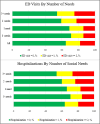Association of Patient-Reported Social Needs with Emergency Department Visits and Hospitalizations Among Federally Qualified Health Center Patients
- PMID: 38717665
- PMCID: PMC11306909
- DOI: 10.1007/s11606-024-08774-y
Association of Patient-Reported Social Needs with Emergency Department Visits and Hospitalizations Among Federally Qualified Health Center Patients
Abstract
Background: Health care systems are increasingly screening for unmet social needs. The association between patient-reported social needs and health care utilization is not well understood.
Objective: To investigate the association between patient-reported social needs, measured by the Protocol for Responding to and Assessing Patients' Assets, Risks, and Experiences (PRAPARE), and inpatient and emergency department (ED) utilization.
Design: This cohort study analyzed merged 2017-2019 electronic health record (EHR) data across multiple health systems.
Participants: Adult patients from a federally qualified health center (FQHC) in central North Carolina who completed PRAPARE as part of a primary care visit with behavioral health services.
Main measures: The count of up to 12 unmet social needs, aggregated as 0, 1, 2, or 3 + . Outcomes include the probability of an ED visit and hospitalization 12 months after PRAPARE assessment, modeled by logistic regressions controlling for age, sex, race, ethnicity, comorbidity burden, being uninsured, and prior utilization in the past 12 months.
Key results: The study population consisted of 1924 adults (38.7% male, 50.1% Black, 36.3% Hispanic, 55.9% unemployed, 68.2% of patients reported 1 + needs). Those with more needs were younger, more likely to be unemployed, and experienced greater comorbidity burden. 35.3% of patients had ED visit(s) and 36.3% had hospitalization(s) 1 year after PRAPARE assessment. In adjusted analysis, having 3 + needs was associated with a percentage point increase in the predicted probability of hospitalization (average marginal effect 0.06, SE 0.03, p < 0.05) compared with having 0 needs. Similarly, having 2 needs (0.07, SE 0.03, p < 0.05) or 3 + needs (0.06, SE 0.03, p < 0.05) was associated with increased probability of ED visits compared to 0 needs.
Conclusions: Patient-reported social needs were common and associated with health care utilization patterns. Future research should identify interventions to address unmet social needs to improve health and avoid potentially preventable escalating medical intervention.
Keywords: PRAPARE; health care utilization; primary care.; screening and response protocols; social determinants of health; unmet social needs.
© 2024. This is a U.S. Government work and not under copyright protection in the US; foreign copyright protection may apply.
Conflict of interest statement
The authors declare that they do not have a conflict of interest.
Figures



References
-
- Social determinants of health. World Health Organization. 2022. https://www.who.int/health-topics/social-determinants-of-health#tab=tab_1. Accessed 1 May 2023.
-
- Commission on Social Determinants of Health. Closing the gap in a generation: health equity through action on the social determinants of health: final report of the commission on social determinants of health. World Health Organization, 2008.
MeSH terms
Grants and funding
LinkOut - more resources
Full Text Sources
Miscellaneous

